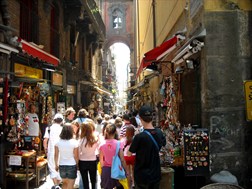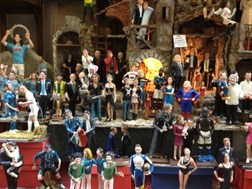Via San Gregorio Armeno and the Neapolitan Nativity scene
 In Naples and its kingdom the Nativity scene already made its appearance in the fourteenth century, only to become one of the most characteristic elements of the city’s culture and identity. From the fifteenth century the figures of the first sculptors spread, in wood and later in terracotta. With the Baroque era the golden age of the Neapolitan Nativity scene began and the most famous of the period was built in 1627 by the Piarists for the Duchess: composed of linked mannequins made of wood, covered with clothes and fabric, it was the first Nativity scene which was not fixed, and was indeed dismantled and reassembled every year at Christmas time. It was between the seventeenth and eighteenth century that the Neapolitan Nativity scene took on some of its characteristics: dummies and statues became progressively smaller and the Nativity scenes were gradually enriched by places and characters drawn from everyday life, from the streets and squares of the city, with the most humble members of the population, such as innkeepers, shoemakers, taverners, vagabonds, dwarfs and the remains of Greek and Roman temples in the area of Naples. In addition, in the eighteenth century the Nativity scene came from churches and entered the homes of the aristocracy and the richer middle class for the first time, giving rise to a real competition for the most beautiful and dramatic Nativity scenes, on which great artists and sculptors often worked.
In Naples and its kingdom the Nativity scene already made its appearance in the fourteenth century, only to become one of the most characteristic elements of the city’s culture and identity. From the fifteenth century the figures of the first sculptors spread, in wood and later in terracotta. With the Baroque era the golden age of the Neapolitan Nativity scene began and the most famous of the period was built in 1627 by the Piarists for the Duchess: composed of linked mannequins made of wood, covered with clothes and fabric, it was the first Nativity scene which was not fixed, and was indeed dismantled and reassembled every year at Christmas time. It was between the seventeenth and eighteenth century that the Neapolitan Nativity scene took on some of its characteristics: dummies and statues became progressively smaller and the Nativity scenes were gradually enriched by places and characters drawn from everyday life, from the streets and squares of the city, with the most humble members of the population, such as innkeepers, shoemakers, taverners, vagabonds, dwarfs and the remains of Greek and Roman temples in the area of Naples. In addition, in the eighteenth century the Nativity scene came from churches and entered the homes of the aristocracy and the richer middle class for the first time, giving rise to a real competition for the most beautiful and dramatic Nativity scenes, on which great artists and sculptors often worked.
 In Naples nowadays, the tradition of the Nativity scene is still alive, despite not attaining the glories of the Bourbon period any more. In addition to churches and private homes, the representations of the nativity of Jesus are preserved in some historical exemplars of high artistic value, in important civic institutions, as is the case, for example, of the presepe Cuciniello in the Museum of the Charterhouse of San Martino (Saint Martin) and the Nativity scene of the Bank of Naples, exhibited in the Royal Palace. However, the place that best represents the tradition of the Neapolitan Nativity scene is in via San Gregorio Armeno (image 1), where craft shops and permanent exhibits provide the opportunity to admire and purchase not only classic Neapolitan Nativity scene figurines and scenes (like shepherds, the Magi, the Cicci Bacco (the drunkard), the Benin (sleeping shepherd), the prostitute, the monk, the fisherman, the gypsy, the bridge, the oven, the tavern, the well, etc.) but also depictions of popular and modern personalities, such as politicians, athletes and actors (image 2). The tradition of the Nativity scene throughout the ancient kingdom of Naples is kept alive by the numerous examples of living Nativity scenes, organized in various locations in southern Italy.
In Naples nowadays, the tradition of the Nativity scene is still alive, despite not attaining the glories of the Bourbon period any more. In addition to churches and private homes, the representations of the nativity of Jesus are preserved in some historical exemplars of high artistic value, in important civic institutions, as is the case, for example, of the presepe Cuciniello in the Museum of the Charterhouse of San Martino (Saint Martin) and the Nativity scene of the Bank of Naples, exhibited in the Royal Palace. However, the place that best represents the tradition of the Neapolitan Nativity scene is in via San Gregorio Armeno (image 1), where craft shops and permanent exhibits provide the opportunity to admire and purchase not only classic Neapolitan Nativity scene figurines and scenes (like shepherds, the Magi, the Cicci Bacco (the drunkard), the Benin (sleeping shepherd), the prostitute, the monk, the fisherman, the gypsy, the bridge, the oven, the tavern, the well, etc.) but also depictions of popular and modern personalities, such as politicians, athletes and actors (image 2). The tradition of the Nativity scene throughout the ancient kingdom of Naples is kept alive by the numerous examples of living Nativity scenes, organized in various locations in southern Italy.
